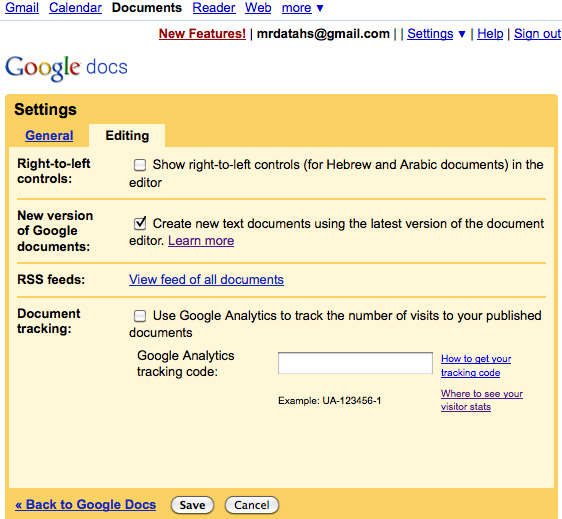Google Apps updates: Enough to compete with Office 2010?

As with most things in tech, that depends. As Sam Diaz pointed out in his coverage of the updates from the Atmosphere event Monday, "Google has been aggressively targeting its cloud-based Google Apps at the enterprise, hosting events like these to spread the word on the strength of the suite." So has Google made its case?
See Gallery: Office 2010 Beta vs. Google Apps updates
In many ways, the polish and enhancements represented by these updates are just enough to provide the average user with everything they need: more reasonable control of layout, improved formula handling, better previews, and improved fidelity. The very fact that Docs (when enabled as shown in the image below) has a ruler with tab stops, margins, and indents will adequately Microsoft-ize the interface for a lot of users.
Of course, Microsofties take a fairly tongue-in-cheek approach to these new features. Andrew Kisslo, a Sr. Product Manager with the Office group, blogged about the new features on Wednesday, noting, "Rumor is the WordPad Team is very nervous about that leap in productivity gain. (Yes that’s a joke.)" Is it a bad sign that he even quoted me?
...I think last week’s post by Chris Dawson on the Googling Google ZDNet blog says it all, “Office 2010 rocks out loud. I may spend a lot of time in the cloud, but I also often have to produce publication-ready documents. Besides, have you ever tried to do a mail merge in Google Docs? Of course you haven’t, because you can’t.”
I can't deny that I said it. I can't even deny that I believe it. You know what else I can't deny? I'm actually looking forward to the Office/Sharepoint 2010 launch that I'll be attending in May or that my next computer is going to be a RAM/processor beast so the Windows 7 VM I run will be able to run Office 2010 with complete ease. I might even (gasp!) run Windows 7 on the computer as the desktop platform, all because of two desktop suites: Office 2010 and Adobe Creative Suite. The latter runs quite well on the Mac, too, but is pretty resource-hungry, so I'd rather not be running Windows (and Office) in a virtual machine while I use CS5 at the same time.
As I write this, I can hear the collective groan:
But Dawson, you're a huge cloud advocate! What's with all this desktop nonsense? And Windows besides? What happened to Ubuntu? Weren't open source, web-based tools going to save the world?
This goes back to the original question I posed in the headline of this blog: Do the updates to Google Apps make it competitive with Office 2010? It all depends on how you use the products. The sort of document layout control that Google has added to Docs was never part of the original vision for the online suite. Docs was all about producing content collaboratively, most of which was going to end up online anyway, where document margins and tab stops are irrelevant. However, as it became clear that Docs would need to compete with Office and Sharepoint as an inexpensive cloud-based alternative to the Microsoft ecosystem, features to make Apps look, feel, and behave more like an office suite became necessary. So now Docs has a ruler.
Office 2010 has more features than I'd care to count and will be an invaluable set of tools for power users. It blows anything else out there away. It's also going to be bloody expensive. The updates to Apps, on the other hand, not only move users closer to the ideal of any-browser, anywhere access to their files (for viewing, editing, and creating, although we're not quite there yet on all fronts) via HTML 5, but also come at no additional cost.
Is a ruler revolutionary? Of course not, but it's remarkably handy. I really value the ability to produce and manage print-ready documents from any browser and the growing capabilities to access and modify documents via selected smartphones is incredibly welcome for those of us who make full use of Docs as a repository for what we write and create. Add to that enhancements to spreadsheet functionality and the ability to collaboratively create drawings like the one below (or, more likely, charts, workflows, and whiteboard applications), and Apps becomes very compelling.
However, Apps is not going to steal too many customers who really leverage the power of Office. It's going to appeal to the same organizations who value ubiquitous, inexpensive access to collaborative documents and who have either already adopted Apps or were waiting for incremental improvements to "go Google."
Can Apps compete with Office? Not feature-for-feature and even most organizations who go Google will probably use Office, InDesign, or other desktop products to make production-ready documents and websites. However, groups can design highly effective workflows around creation of content in the cloud, with a solid spit-shine on the desktop. Depending on their needs, others can simply push Apps content straight to the web and make use of its webcentricity (yes, I think that's a new word; expect me to use it more because I like it). In these cases, it doesn't need to compete feature-for-feature; it needs to make it easy to work in a browser instead of on a computer. In that way, Apps is not just competitive but utterly dominant.
So what do you need from your productivity applications? Until you answer that question, you can't answer the question of competitiveness.
